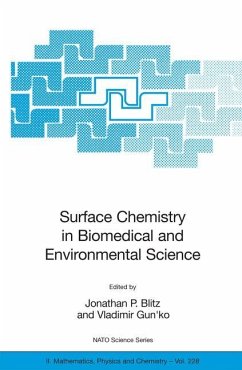Jonathan P. Blitz / Vladimir M. Gun'ko (eds.)
Surface Chemistry in Biomedical and Environmental Science
Herausgegeben:Blitz, Jonathan P.; Gun'ko, Vladimir M.
Jonathan P. Blitz / Vladimir M. Gun'ko (eds.)
Surface Chemistry in Biomedical and Environmental Science
Herausgegeben:Blitz, Jonathan P.; Gun'ko, Vladimir M.
- Gebundenes Buch
- Merkliste
- Auf die Merkliste
- Bewerten Bewerten
- Teilen
- Produkt teilen
- Produkterinnerung
- Produkterinnerung
In September 2005 a NATO Advanced Research Workshop convened in Kiev to discuss the current state of the art in surface chemistry and nanomaterials research, with a view towards biomedical and environmental applications. This volume represents the fine work presented at this workshop, consisting of a unique mixture of reviews as well as primary research articles from leading laboratories in Eastern and Western Europe as well as the US.
A common theme throughout much of this volume involves adsorption and interfacial behavior of nanomaterials including core-shell particles, nanoparticles…mehr
Andere Kunden interessierten sich auch für
![Recent Advances in Adsorption Processes for Environmental Protection and Security Recent Advances in Adsorption Processes for Environmental Protection and Security]() José Paulo Mota / Svetlana Lyubchik (eds.)Recent Advances in Adsorption Processes for Environmental Protection and Security185,99 €
José Paulo Mota / Svetlana Lyubchik (eds.)Recent Advances in Adsorption Processes for Environmental Protection and Security185,99 €![Magnetic Nanostructures in Modern Technology Magnetic Nanostructures in Modern Technology]() Bruno Azzerboni / Giovanni Asti / Luigi Pareti / Massimo Ghidini (eds.)Magnetic Nanostructures in Modern Technology118,99 €
Bruno Azzerboni / Giovanni Asti / Luigi Pareti / Massimo Ghidini (eds.)Magnetic Nanostructures in Modern Technology118,99 €![Chemicals as Intentional and Accidental Global Environmental Threats Chemicals as Intentional and Accidental Global Environmental Threats]() Lubomir Simeonov / Elisabeta Chirila (eds.)Chemicals as Intentional and Accidental Global Environmental Threats110,99 €
Lubomir Simeonov / Elisabeta Chirila (eds.)Chemicals as Intentional and Accidental Global Environmental Threats110,99 €![Chemicals as Intentional and Accidental Global Environmental Threats Chemicals as Intentional and Accidental Global Environmental Threats]() Lubomir Simeonov / Elisabeta Chirila (eds.)Chemicals as Intentional and Accidental Global Environmental Threats110,99 €
Lubomir Simeonov / Elisabeta Chirila (eds.)Chemicals as Intentional and Accidental Global Environmental Threats110,99 €![Maurice Brookhart Maurice Brookhart]() Maurice Brookhart22,99 €
Maurice Brookhart22,99 €![Functionalized Carbon Nanotubes for Biomedical Applications Functionalized Carbon Nanotubes for Biomedical Applications]() Functionalized Carbon Nanotubes for Biomedical Applications234,99 €
Functionalized Carbon Nanotubes for Biomedical Applications234,99 €![Functional Biomaterials. 2 volumes Functional Biomaterials. 2 volumes]() Functional Biomaterials. 2 volumes199,00 €
Functional Biomaterials. 2 volumes199,00 €-
-
-
In September 2005 a NATO Advanced Research Workshop convened in Kiev to discuss the current state of the art in surface chemistry and nanomaterials research, with a view towards biomedical and environmental applications. This volume represents the fine work presented at this workshop, consisting of a unique mixture of reviews as well as primary research articles from leading laboratories in Eastern and Western Europe as well as the US.
A common theme throughout much of this volume involves adsorption and interfacial behavior of nanomaterials including core-shell particles, nanoparticles derived from oxides, mixed oxides, carbon, carbon/oxide hybrids, functionalized nanoparticles, polymeric biomaterials, and more. The behavior and design of these nanomaterials for adsorption (or sometimes the lack thereof) of toxins, pollutants, narcotics, warfare agents and various biomolecules are studied with a mix of experimental and theoretical approaches. This volume holds a special niche in describing the current state of the art in the fundamentals and applications of a variety of nanomaterials.
A common theme throughout much of this volume involves adsorption and interfacial behavior of nanomaterials including core-shell particles, nanoparticles derived from oxides, mixed oxides, carbon, carbon/oxide hybrids, functionalized nanoparticles, polymeric biomaterials, and more. The behavior and design of these nanomaterials for adsorption (or sometimes the lack thereof) of toxins, pollutants, narcotics, warfare agents and various biomolecules are studied with a mix of experimental and theoretical approaches. This volume holds a special niche in describing the current state of the art in the fundamentals and applications of a variety of nanomaterials.
Produktdetails
- Produktdetails
- NATO Science Series II Mathematics, Physics and Chemistry 228
- Verlag: Springer / Springer Netherlands
- Artikelnr. des Verlages: 978-1-4020-4739-8
- 2006
- Seitenzahl: 464
- Erscheinungstermin: 21. August 2006
- Englisch
- Abmessung: 241mm x 160mm x 30mm
- Gewicht: 1355g
- ISBN-13: 9781402047398
- ISBN-10: 1402047398
- Artikelnr.: 22064437
- NATO Science Series II Mathematics, Physics and Chemistry 228
- Verlag: Springer / Springer Netherlands
- Artikelnr. des Verlages: 978-1-4020-4739-8
- 2006
- Seitenzahl: 464
- Erscheinungstermin: 21. August 2006
- Englisch
- Abmessung: 241mm x 160mm x 30mm
- Gewicht: 1355g
- ISBN-13: 9781402047398
- ISBN-10: 1402047398
- Artikelnr.: 22064437
Jonathan P. Blitz, Eastern Illinois University, Charleston, USA / Vladimir Gun'ko, Institute of Surface Chemistry, Kiev, Ukraine
Fundamentals.- Water structuring at colloidal surfaces.- Microgels and core-shell particles.- Microencapsulation: fundamentals, methods and applications.- The molecular layering method: progress in science and practical works for creation of functional nanomaterials.- Analysis of surface structures using XPS with external stimuli.- Modification and coating of polymer surfaces.- Is it possible to generalize the problems of porous materials formation, study and exploitation?.- Theoretical analysis of surface pressure of monolayers formed by nano-particles.- Oxide, carbon, and carbon/mineral adsorbents for toxic, explosive, and narcotic compounds - synthesis, properties, and applications.- Porous polymeric nanocomposites filled with chemically modified fumed silicas.- Ion-electrostatic interaction in systems of inorganic nanoparticles and biological cells in electrolyte solution.- Structural and adsorption characteristics of pyrocabon-mineral adsorbents.- Synthesis and structural/adsorption characteristics of unmodified and modified hybrid carbon/mineral adsorbents.- Biomedical Applications of Nanomaterials.- Surface Functionalization for Biomedical Applications.- Surface modifications to influence adhesion of biological cells and adsorption of globular proteins.- Fundamentals of nanosilica applications for human protection.- Medical aspects of application of highly disperse amorphous silica.- The interaction of nanostructured biomaterials with human cell cultures. The choice of cell cultures for use as biocompatability probes.- Physical characterisation of a polycaprolactone tissue scaffold.- Nanostructured and nanocomposite hydrogels for biomedical applications.- An overview on the toxicity of inhaled nanoparticles.- Detection of V-type nerve agent degradation productsusing a polypyrrole/pyrroloquinoline quinone-modified electrode.- Biological applications of functionalized carbon nanoparticles.- Interaction of cells with nanoparticles.- The role of nature and structure of surface sites in the biological response to silica particles.- Magnetically sensitive nanocomposites for medical and biological applications.- Hydrophobized silica nanocomposites with immobilized antioxidants (vitamins C an d E).- Interaction of some biomolecules with modified nanosilica surfaces studied by quantum chemistry.- Environmental Applications of Nanomaterials.- Synthesis and characterization of ordered mesoporous materials for removal of heavy metal ions.- Functionalized surfaces: silica structure and metal ion adsorption behavior.- Heterogeneously catalyzed alkane isomerization ? towards 100% selectivity.- Low temperature oxidation of carbon monoxide over alkali-metal promoted palladium-tin oxide catalysts.- Nanoparticles of aluminium salts hydrolysis products in water treatment and disinfection.- Co-adsorption of the low molecular carboxylic acids and cadmium ions at the metal oxide/electrolyte interface.- Interaction of Phenolic Pollutants with PNIPA hydrogels.- Nanoscale oxides as destructive sorbents for halogenated hydrocarbons.- Dynamic adsorption of tert-butylbenzene, cyclohexane and water vapours on fixed activated carbon/molecular sieve beds.- Influence of pre-adsorbed NaCl on breakthrough dynamics of TBB and DMMP on activated carbon at different airstream humidities.- Influence of the nature of active surface sites of highly disperse oxides on adsorption of heavy metal ions.
Fundamentals.- Water structuring at colloidal surfaces.- Microgels and core-shell particles.- Microencapsulation: fundamentals, methods and applications.- The molecular layering method: progress in science and practical works for creation of functional nanomaterials.- Analysis of surface structures using XPS with external stimuli.- Modification and coating of polymer surfaces.- Is it possible to generalize the problems of porous materials formation, study and exploitation?.- Theoretical analysis of surface pressure of monolayers formed by nano-particles.- Oxide, carbon, and carbon/mineral adsorbents for toxic, explosive, and narcotic compounds – synthesis, properties, and applications.- Porous polymeric nanocomposites filled with chemically modified fumed silicas.- Ion-electrostatic interaction in systems of inorganic nanoparticles and biological cells in electrolyte solution.- Structural and adsorption characteristics of pyrocabon-mineral adsorbents.- Synthesis and structural/adsorption characteristics of unmodified and modified hybrid carbon/mineral adsorbents.- Biomedical Applications of Nanomaterials.- Surface Functionalization for Biomedical Applications.- Surface modifications to influence adhesion of biological cells and adsorption of globular proteins.- Fundamentals of nanosilica applications for human protection.- Medical aspects of application of highly disperse amorphous silica.- The interaction of nanostructured biomaterials with human cell cultures. The choice of cell cultures for use as biocompatability probes.- Physical characterisation of a polycaprolactone tissue scaffold.- Nanostructured and nanocomposite hydrogels for biomedical applications.- An overview on the toxicity of inhaled nanoparticles.- Detection of V-type nerve agent degradation productsusing a polypyrrole/pyrroloquinoline quinone-modified electrode.- Biological applications of functionalized carbon nanoparticles.- Interaction of cells with nanoparticles.- The role of nature and structure of surface sites in the biological response to silica particles.- Magnetically sensitive nanocomposites for medical and biological applications.- Hydrophobized silica nanocomposites with immobilized antioxidants (vitamins C an d E).- Interaction of some biomolecules with modified nanosilica surfaces studied by quantum chemistry.- Environmental Applications of Nanomaterials.- Synthesis and characterization of ordered mesoporous materials for removal of heavy metal ions.- Functionalized surfaces: silica structure and metal ion adsorption behavior.- Heterogeneously catalyzed alkane isomerization ? towards 100% selectivity.- Low temperature oxidation of carbon monoxide over alkali-metal promoted palladium-tin oxide catalysts.- Nanoparticles of aluminium salts hydrolysis products in water treatment and disinfection.- Co-adsorption of the low molecular carboxylic acids and cadmium ions at the metal oxide/electrolyte interface.- Interaction of Phenolic Pollutants with PNIPA hydrogels.- Nanoscale oxides as destructive sorbents for halogenated hydrocarbons.- Dynamic adsorption of tert-butylbenzene, cyclohexane and water vapours on fixed activated carbon/molecular sieve beds.- Influence of pre-adsorbed NaCl on breakthrough dynamics of TBB and DMMP on activated carbon at different airstream humidities.- Influence of the nature of active surface sites of highly disperse oxides on adsorption of heavy metal ions.
Fundamentals.- Water structuring at colloidal surfaces.- Microgels and core-shell particles.- Microencapsulation: fundamentals, methods and applications.- The molecular layering method: progress in science and practical works for creation of functional nanomaterials.- Analysis of surface structures using XPS with external stimuli.- Modification and coating of polymer surfaces.- Is it possible to generalize the problems of porous materials formation, study and exploitation?.- Theoretical analysis of surface pressure of monolayers formed by nano-particles.- Oxide, carbon, and carbon/mineral adsorbents for toxic, explosive, and narcotic compounds - synthesis, properties, and applications.- Porous polymeric nanocomposites filled with chemically modified fumed silicas.- Ion-electrostatic interaction in systems of inorganic nanoparticles and biological cells in electrolyte solution.- Structural and adsorption characteristics of pyrocabon-mineral adsorbents.- Synthesis and structural/adsorption characteristics of unmodified and modified hybrid carbon/mineral adsorbents.- Biomedical Applications of Nanomaterials.- Surface Functionalization for Biomedical Applications.- Surface modifications to influence adhesion of biological cells and adsorption of globular proteins.- Fundamentals of nanosilica applications for human protection.- Medical aspects of application of highly disperse amorphous silica.- The interaction of nanostructured biomaterials with human cell cultures. The choice of cell cultures for use as biocompatability probes.- Physical characterisation of a polycaprolactone tissue scaffold.- Nanostructured and nanocomposite hydrogels for biomedical applications.- An overview on the toxicity of inhaled nanoparticles.- Detection of V-type nerve agent degradation productsusing a polypyrrole/pyrroloquinoline quinone-modified electrode.- Biological applications of functionalized carbon nanoparticles.- Interaction of cells with nanoparticles.- The role of nature and structure of surface sites in the biological response to silica particles.- Magnetically sensitive nanocomposites for medical and biological applications.- Hydrophobized silica nanocomposites with immobilized antioxidants (vitamins C an d E).- Interaction of some biomolecules with modified nanosilica surfaces studied by quantum chemistry.- Environmental Applications of Nanomaterials.- Synthesis and characterization of ordered mesoporous materials for removal of heavy metal ions.- Functionalized surfaces: silica structure and metal ion adsorption behavior.- Heterogeneously catalyzed alkane isomerization ? towards 100% selectivity.- Low temperature oxidation of carbon monoxide over alkali-metal promoted palladium-tin oxide catalysts.- Nanoparticles of aluminium salts hydrolysis products in water treatment and disinfection.- Co-adsorption of the low molecular carboxylic acids and cadmium ions at the metal oxide/electrolyte interface.- Interaction of Phenolic Pollutants with PNIPA hydrogels.- Nanoscale oxides as destructive sorbents for halogenated hydrocarbons.- Dynamic adsorption of tert-butylbenzene, cyclohexane and water vapours on fixed activated carbon/molecular sieve beds.- Influence of pre-adsorbed NaCl on breakthrough dynamics of TBB and DMMP on activated carbon at different airstream humidities.- Influence of the nature of active surface sites of highly disperse oxides on adsorption of heavy metal ions.
Fundamentals.- Water structuring at colloidal surfaces.- Microgels and core-shell particles.- Microencapsulation: fundamentals, methods and applications.- The molecular layering method: progress in science and practical works for creation of functional nanomaterials.- Analysis of surface structures using XPS with external stimuli.- Modification and coating of polymer surfaces.- Is it possible to generalize the problems of porous materials formation, study and exploitation?.- Theoretical analysis of surface pressure of monolayers formed by nano-particles.- Oxide, carbon, and carbon/mineral adsorbents for toxic, explosive, and narcotic compounds – synthesis, properties, and applications.- Porous polymeric nanocomposites filled with chemically modified fumed silicas.- Ion-electrostatic interaction in systems of inorganic nanoparticles and biological cells in electrolyte solution.- Structural and adsorption characteristics of pyrocabon-mineral adsorbents.- Synthesis and structural/adsorption characteristics of unmodified and modified hybrid carbon/mineral adsorbents.- Biomedical Applications of Nanomaterials.- Surface Functionalization for Biomedical Applications.- Surface modifications to influence adhesion of biological cells and adsorption of globular proteins.- Fundamentals of nanosilica applications for human protection.- Medical aspects of application of highly disperse amorphous silica.- The interaction of nanostructured biomaterials with human cell cultures. The choice of cell cultures for use as biocompatability probes.- Physical characterisation of a polycaprolactone tissue scaffold.- Nanostructured and nanocomposite hydrogels for biomedical applications.- An overview on the toxicity of inhaled nanoparticles.- Detection of V-type nerve agent degradation productsusing a polypyrrole/pyrroloquinoline quinone-modified electrode.- Biological applications of functionalized carbon nanoparticles.- Interaction of cells with nanoparticles.- The role of nature and structure of surface sites in the biological response to silica particles.- Magnetically sensitive nanocomposites for medical and biological applications.- Hydrophobized silica nanocomposites with immobilized antioxidants (vitamins C an d E).- Interaction of some biomolecules with modified nanosilica surfaces studied by quantum chemistry.- Environmental Applications of Nanomaterials.- Synthesis and characterization of ordered mesoporous materials for removal of heavy metal ions.- Functionalized surfaces: silica structure and metal ion adsorption behavior.- Heterogeneously catalyzed alkane isomerization ? towards 100% selectivity.- Low temperature oxidation of carbon monoxide over alkali-metal promoted palladium-tin oxide catalysts.- Nanoparticles of aluminium salts hydrolysis products in water treatment and disinfection.- Co-adsorption of the low molecular carboxylic acids and cadmium ions at the metal oxide/electrolyte interface.- Interaction of Phenolic Pollutants with PNIPA hydrogels.- Nanoscale oxides as destructive sorbents for halogenated hydrocarbons.- Dynamic adsorption of tert-butylbenzene, cyclohexane and water vapours on fixed activated carbon/molecular sieve beds.- Influence of pre-adsorbed NaCl on breakthrough dynamics of TBB and DMMP on activated carbon at different airstream humidities.- Influence of the nature of active surface sites of highly disperse oxides on adsorption of heavy metal ions.







